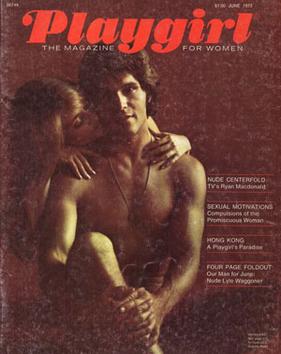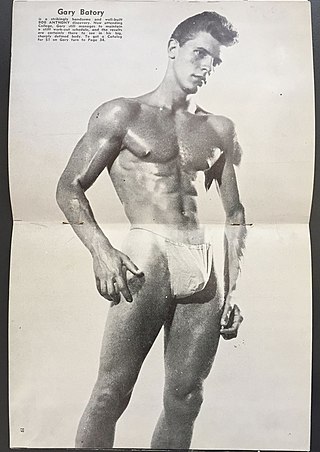Related Research Articles

Playgirl was an American magazine that featured general interest articles, lifestyle and celebrity news, in addition to nude or semi-nude men. In the 1970s and 1980s, the magazine printed monthly and was marketed mainly to women, although it had a significant gay male readership.

A Playmate is a female model featured in the centerfold/gatefold of Playboy magazine as Playmate of the Month (PMOTM). The PMOTM's pictorial includes nude photographs and a centerfold poster, along with a pictorial biography and the "Playmate Data Sheet", which lists her birthdate, measurements, turn-ons, and turn-offs. At the end of the year, one of the 12 Playmates of the Month is named Playmate of the Year (PMOTY). Every Playmate of the Month is awarded a prize of US$25,000 and each Playmate of the Year receives an additional prize of US$100,000 plus a car and other discretionary gifts. In addition, Anniversary Playmates are usually chosen to celebrate a milestone year of the magazine. The use of the word "Playmate" in a sexual sense did not originate with Playboy, and was seen at least as early as 1950 in Vue magazine.

Pornographic magazines or erotic magazines, sometimes known as adult, sex or top-shelf magazines, are magazines that contain content of an explicitly sexual nature. Publications of this kind may contain images of attractive naked subjects, as is the case in softcore pornography, and, in the usual case of hardcore pornography, depictions of masturbation, oral, manual, vaginal or anal sex.

The centerfold or centrefold of a magazine is the inner pages of the middle sheet, usually containing a portrait, such as a pin-up or a nude. The term can also refer to the model featured in the portrait. In saddle-stitched magazines, the centerfold does not have any blank space cutting through the image.

Johnson Publishing Company, Inc. (JPC) was an American publishing company founded in November 1942 by African-American businessman John H. Johnson. It was headquartered in Chicago, Illinois. JPC was privately held and run by Johnson until his death in 2005. His publications "forever changed the popular representation of African Americans." The writing portrayed African Americans as they saw themselves and its photojournalism made history. Led by its flagship publication, Ebony, Johnson Publishing was at one time the largest African-American-owned publishing firm in the United States. JPC also published Jet, a weekly news magazine, from November 1951 until June 2014, when it became digital only. In the 1980s, the company branched into film and television.

Oui was a men's adult pornographic magazine published in the United States and featuring explicit nude photographs of models, with full page pin-ups, centerfolds, interviews and other articles, and cartoons. Oui ceased publication in 2007.

Men Only is a British magazine title that originated in 1935 as a pocket-sized men's magazine. It became a standard-sized pin-up magazine in the 1950s and was relaunched in 1971 by Paul Raymond Publications as a soft-core pornographic magazine.
Players was an American monthly softcore men's magazine. It was often nicknamed "the black Playboy" for its attempt at providing the African-American public with a racy, yet elegant reading choice. Once new black-centric magazines came in to the fold, publications such as The Messenger, Opportunity, and The Crisis would regularly show and portray photographs and short descriptions of Black life in America, specifically Women, to enlighten the masses as both moral and aspirational figures. These images were originally to challenge racist stereotypes, but would turn it on its head to create a vision of empowerment. Players Magazine would come along, as it would take this narrative and flip it to a sexualized state, which would change the world of snuff magazines. Players Magazine, amongst the others before it, attempted to end the narrative of ignorance towards Black life or the everyday representation of Black people.
References
- 1 2 "Antiquarian Bookseller's Association of America". abaa.org. ABAA, Bibliopolis, LLC, and Biblio.com, Inc. Retrieved March 28, 2016.[ permanent dead link ]
- 1 2 3 4 5 Nishikawa, Kinohi (2002). Race, Respectability And The Short Life Of Duke Magazine. Johns Hopkins University Press.
- ↑ Davis, Elroy (June 1957). "Duchess of the Month". Duke. Vol. 1, no. 1. Duke Publishing Co. p. 33.
- ↑ "Jets Pin-Ups For 1957". Jet. Vol. 1, no. 1. Duke Publishing Co. January 3, 1957. p. 33.
- ↑ "Masthead". Duke. Vol. 1, no. 1. Duke Publishing Co. June 1957. p. 3.